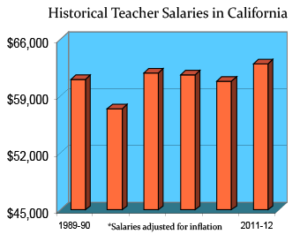California Teaching Salaries and Benefits

As you’ve considered a career in teaching, you’ve most likely focused heavily on the hours you’ll work and the level of salary you might receive. While most teachers earn competitive wages, the benefits they gain in return for their services sometimes prove far more important.
Thanks to the numerous employee benefits afforded to teachers in California, educators are more capable of attending to a variety of challenges they might encounter in life. By providing teachers with access to health insurance options and retiree pension benefits, California ensures its teachers can confidently prepare for not only the present, but for the future as well.
Learn more about becoming a teacher. Contact schools offering teacher education/certification programs in California.
Teacher Salaries in California by Education
As teachers further their educations and gain experience in the field, they receive pay increases that reflect their dedication and hard work. Salaries vary between school districts, but the following are some examples of the salaries you can expect in California:
| Experience | Bachelor’s | Master’s |
|---|---|---|
| At 3 years | $49,815 | $50,662 |
| At 6 years | $52,094 | $57,386 | At 9 years | $58,818 | $64,110 |
| At 12 years | $66,118 | $70,833 |
Source: Long Beach Unified School District
Retiring in California
If you become employed by a California public school, you’re entered into the California Teachers’ Retirement System (TRS), which provides teachers with a Defined Benefit Plan to help them reach their future goals.
In California, you’re entitled to full retirement benefits if you meet the normal retirement requirements. Otherwise, you are still eligible to receive reduced benefits. To reach normal retirement, you must meet the following requirements:
- At least 50 years old with 30 years of service
- At least 55 years old with five years of service
As of 2011, the TRS covers over 856,360 members, and has distributed nearly $10.2 billion in benefit payments. These payments are funded through a mix of teacher, state, and employer contributions that help to sustain the fund for future beneficiaries.
Teachers contribute 8% of their monthly salaries into a state pension fund, while their employers contribute an additional 8.25%. On top of these payments, the state of California contributes another 2% into the fund.
As you reach retirement, you’ll begin to receive these funds in lifetime monthly payments. These monthly payments are determined by a series of calculations that take into account your age, years of service, and average salary.
Age Factor
times
Service Credit
times
Compensation
Age Factor
The age factor is a percentage of your final compensation adjusted by your age at retirement. The age factor is set at 2% for those who reach at least 60 years before retirement, up to a maximum of 2.4% if you retire after 60.
Service Credit
The service credit is the amount of years you’ve served as a teacher. One full year is equal to one service credit.
Compensation
Your highest one year earnable salary.
According to the California TRS website, the median age most teachers retire is at 61.9 years. The median service credit they accrue is 25.5 years. Under this formula, these teachers receive an average monthly benefit of $4,088.
In addition to the Defined Retirement Plan, the state of California also offers teachers a supplemental plan similar to a 401(k). A percentage of any creditable compensation earned while performing overtime, summer school, or overload time goes into a personal fund. That fund earns interest over time, and is then distributed back to the employee upon retirement.
If you’re interested in learning more about the retirement options offered to teachers in California, explore the California Teacher Retirement System.
Access to Affordable Health Insurance
In California, teachers are offered health insurance plans through the California Public Employee Retirement System (CalPERS). According to the department’s website, CalPERS is the third largest purchaser of healthcare in the nation, providing benefits to nearly 1.3 million public employees and their families.
CalPERS offers teachers three different health plans:
- Preferred Provider Organizations (PPOs)
- Health Maintenance Organizations (HMOs)
- Exclusive Provider Organizations (EPOs)
HMO
Under the HMO plan, teachers must receive care from in-network providers, but receive that care at a fixed cost. This plan requires you to select a primary care physician to advise you on your health needs. Teachers in the HMO plan must pay a small co-payment for most services.
PPO
The PPO plan is a more open-ended plan, not requiring teachers to seek a primary care physician and instead allows them to access a network of health care providers known as preferred providers. Under the PPO plan, teachers are encouraged to seek services from in-network preferred providers, but may seek out-of-network providers at higher rates.
EPO
The EPO plan is similar to the HMO plan, except the EPO plan is only offered to Colusa, Mendocino, and Sierra County teachers. Unlike the HMO plan, members seek services from the PPO network of preferred providers.
Each plan will ensure your proper coverage under the Patient Protection and Affordable Care Act, but contain slights adjustments for services and care covered. Most plans cover the following services:
- Hospital Stays
- Emergency Service
- Ambulance Service
- Physician Services
- Diagnostic Services
- Prescription Drugs
- Home Health Services
- Skilled Nursing Care
- Hearing Aid Services
- Vision Exams/Screening
For a full list of the services provided (and not provided) by the health insurance plans provided by CalPERS, explore more California health insurance plans.





